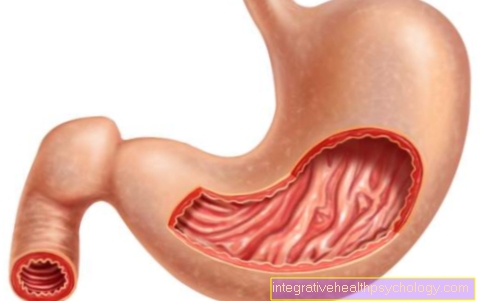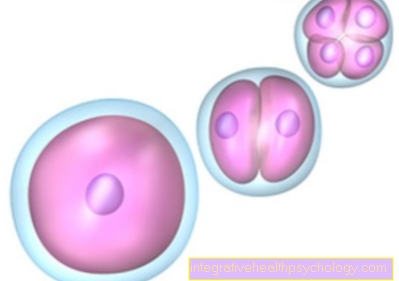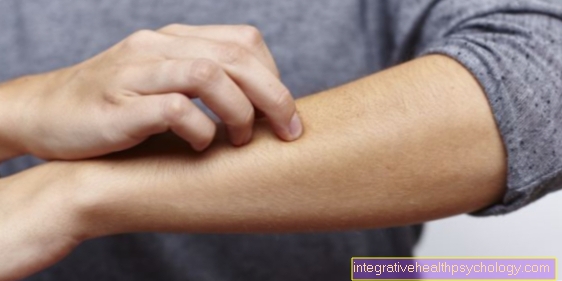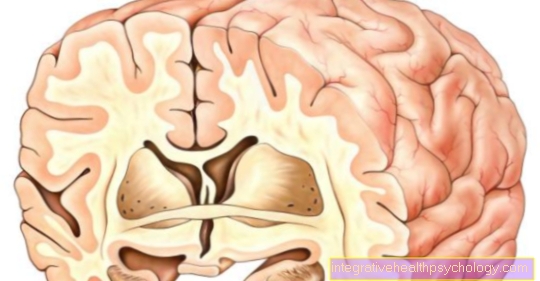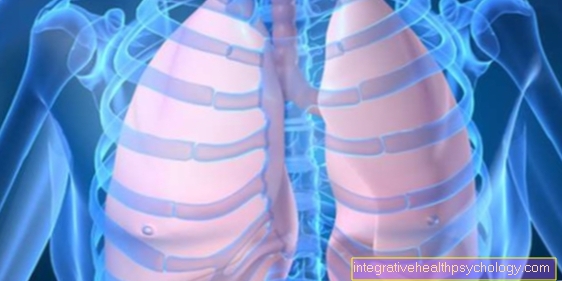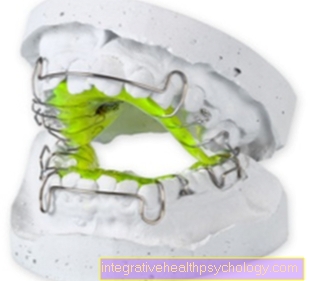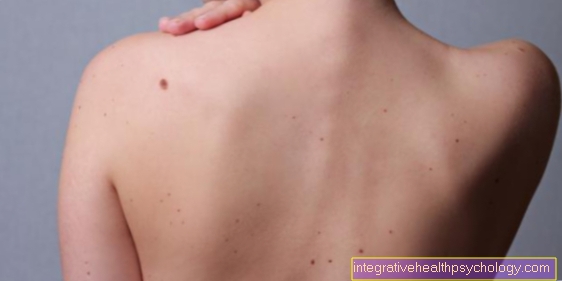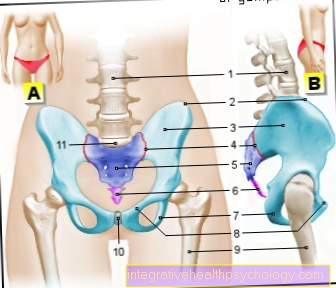Brachial plexus
introduction
The brachial plexus is a network of the anterior branches of the spinal cord nerves of the C5-Th1 vertebrae. This is another name for the lower four cervical vertebrae and the uppermost thoracic vertebra.
This "Arm braid“Belongs to the so-called peripheral nervous systemwhich lies outside the cranial bone and the spinal canal and that central nervous system connects with the organs of success.
At first glance, the brachial plexus appears very confusing and confusing. However, once you have understood the basic structure, in the case of brachial plexus paralysis, conclusions can often be drawn about the lesion of the affected nerve and the doctor can make a precise diagnosis.

construction
The individual branches of the anterior spinal nerves of our plexus initially connect to form the so-called. Trunci (Stems) after they pull through a triangular passage for several ducts, which in anatomical jargon are called rear Scalene gap designated.
These 3 tribes (Trunci) can be subdivided into:
- the upper trunk: Truncus superior (consisting of spinal nerves C5 and C6)
- the middle trunk: Truncus medius (consisting of spinal nerve C7)
- the lower trunk: the Inferior trunk (consisting of C8 and Th1)
At the transition to our armpit area, this part of the plexus is not called Tribesbut as a small bundle or package. In Latin, the term is often used here Fascicle. These can be subdivided according to their location in relation to our axillary artery.
- the bundle lying on the side: Lateral fasciculus (consisting of spinal nerve C5 - C7)
- the central bundle: Medial fasciculus (consisting of spinal nerve C8 - Th1)
- the bundle at the back: Posterior fasciculus (consisting of spinal nerve C5- Th1)
Ours often branch out from these infraclavicular branches which then run to the muscles of the shoulder. These are explained in more detail in the next section:
Based on their course, our arm nerve plexus can be divided into annoy subdivide that run below the collarbone and above the collarbone. This is of great relevance, above all, for the diagnosis of a doctor.
Nerves that run above the collarbone:
These nerves share their course with our axillary artery and have the following names:
- N. dorsalis scapulae
- N. thoracicus longus
- Suprascapular nerve
- N. subclavius
These nerves can be found under the name Supraclavicular nerves sum up.
Nerves that run below the collarbone:
Lateral fasciculus (C5 - C7)
Musculocutaneous nerve
Lateral pectoral nerve
N. medianus (Radix lateralis)
Medial fasciculus (C8-Th1)
Ulnar nerve
Medial pectoral nerve
N. cutaneus brachii medialis
N. cutaneus antebrachii medialis
Posterior fasciculus (C5-Th1)
Radial nerve
Axillary nerve
Subscapular nerve
Thoracodorsal nerve
Damage to the supraclavicular nerve
Symptoms
In patients in whom the movement and external rotation of the arm is restricted and associated with pain, the upper clavicle nerves (Supraclavicular nerve) be damaged.
root cause
This can be caused by a long phone call in which you pinch the receiver between your shoulder and your ear, damaging the nerve.
What is a Brachial Plexus Lesion?
Brachial plexus lesions are damage and injuries to the brachial plexus. The nerves that arise from this network are impaired to different degrees depending on the severity of the lesion. An entrapment of the nerves with increased pressure and the resulting damage can be described as a lesion, as can the complete tearing off of one or more nerves.
There are many reasons for such damage: falls on the shoulder, broken collarbones (clavicle fracture), dislocations (dislocations) of the shoulder, or the pressure exerted on a child during birth.
In addition, brachial plexus lesions can result from pressure from anatomical structures that have grown too far in the direction of the brachial plexus. Tumors (especially breast cancer) or enlarged lymph nodes after an inflammation can also lead to a lesion. Symptoms vary widely depending on the severity of the lesion. Paralysis of the arm, disturbances of sensation (sensory disturbances) and pain can occur. Depending on the damage, only parts of the arm or the whole arm are affected.
Brachial plexus pain
Pain in the brachial plexus arises from damage to the nerves that arise from this plexus. The pain or abnormal sensations are localized in the arms or in the upper shoulder area.
Pain occurs when a nerve in the brachial plexus is stimulated with the pain fibers. Often you can feel the damage not only in the place where it occurred. Rather, the pain can spread to the whole area that is supplied with pain fibers by the affected nerve (innervation area).
The pain can take on very different degrees. This also depends on the type of damage. Increased pressure on the brachial plexus (e.g. due to trauma) usually triggers pain, which mainly affects the arm. They are often aggravated with exercise that increases pressure. The pain here can be mild to very severe. On the other hand, sudden, violent pain, especially in the area above the collarbone (supraclavicular), can be an indication of acute brachial neuritis.
An absence of pain does not mean that the plexus is intact. If no pain is felt, although e.g. B. is pinched in the arm, this can also be a sign of impairment. This is especially true if paralysis or simultaneous tingling occurs.
Read more about the topic: Brachial plexus paralysis
What is a brachial plexus block / anesthesia?
A form of local anesthesia (local anesthesia) is called the brachial plexus block. It is used to temporarily switch off the sensations of the arms and parts of the shoulder. The ability to move the stunned areas at will is also lost for the duration of the stun.
A brachial plexus block is usually performed by an anesthetist. It is used for operations on the arms and parts of the shoulder and is an alternative to general anesthesia. As a rule, local anesthetics have fewer risks than general anesthesia.
General anesthesia may still be indicated for large or particularly complicated procedures. The brachial plexus block can also be used therapeutically for persistent pain in this area. A pain reliever is usually chosen that allows movement to continue.
In the brachial plexus block, a needle is pushed near the nerves of the brachial plexus and a local anesthetic is administered through the needle. The area into which the needle sticks can be numbed beforehand with local anesthetics. It is not stabbed directly into the nerves, as this could damage them. The exact course of the needle can be assessed by a simultaneous ultrasound examination.
What is brachial plexus syndrome?
Brachial plexus syndrome is a combination of certain symptoms that result from increased pressure on the nerves of the brachial plexus and the vessels in its vicinity (subclavian artery). It is also known as shoulder girdle compression syndrome.
The pressure increase usually comes about through a bottleneck. This can be formed by a cervical rib, enlarged (hypertrophied) muscles or tendons and ligaments. Two bones lying close together, such as B. The collarbone (clavicle) and the first rib (costa) can be a bottleneck. Depending on the point at which the pressure is increased, one speaks of the scalene syndrome, costoclavicular syndrome or hyperabduction syndrome.
Symptoms often begin with pain or tingling in the arm. They often worsen depending on the movement. Later on, if there is no treatment, paralysis of the arm and muscle breakdown can occur.
Therapy consists of avoiding pain with pain relievers. Targeted exercise and physical therapy can also be helpful. Surgery may also be considered in severe cases, especially if there is a rib in the neck.
What is brachial plexus neuritis / irritation?
Brachial plexus neuritis is an inflammation of the nerve plexus that supplies the arm. This disease is also called neuralgic shoulder amyotrophy. The inflammation often arises from the fact that the immune system produces substances (immune complexes) that damage the nerves after an infection.
The neurtitis can be limited to one arm or affect both. Its onset is very sudden and acute. The symptoms are severe pain and discomfort in the arm and shoulder. After a few days, the pain can turn into paralysis. This usually affects the shoulder muscles, and more rarely the lower arm muscles.
Therapy consists of elevation, warmth, immunosuppressants such as cortisol and pain relievers. In most cases the disease heals on its own, but it can take years.
Here you can find out more about: Nerve inflammation in the arm
Can you see the brachial plexus on the MRI?
The brachial plexus can be seen on MRI. In magnetic resonance imaging, the magnetic properties of some atomic nuclei (e.g. water) can also make small body structures visible. The magnetic fields also penetrate through bones. Therefore, structures that are well protected can also be viewed.
The MRI is particularly suitable for displaying tissues and organs. However, it is also possible to assess nerves with high-resolution devices. Even small damage to the nerves can now be detected with powerful MRIs. One method in which such MRIs are used is magnetic resonance neurography.
Damage to the radial nerve
Symptoms
Sensory disturbances on the back of the hand in the area of the thumb, index finger and middle finger that do not affect the fingertips and numbness in the lower two-thirds of the thumb. In addition, depending on the extent of the damage, a falling hand can result, which makes it impossible for the affected patient to raise his hand.
root cause
The cause of this damage can be a broken upper arm in which the Radial nerve is harmed. This has the specific task Hand muscles to stimulate. If these muscles fail, the symptoms of the falling hand described above result.
In addition, moderate radial paralysis can lead to similar symptoms. A break is not absolutely necessary.
therapy
Depending on the type of fracture and its severity, this has to be weighed up on an individual basis. In the case of moderate radial paralysis, the symptoms may disappear after a few days.
Damage to the ulnar nerve
Symptoms
The uncomfortable feeling that when the elbow hits an object appears for a few seconds is the reason why the name "Funny bones“Has established itself in general language for this region of our human body.
It can lead to a reduced ability of the thumb to draw against the body and the clinical picture of a clawed hand results. Apart from that, numbness is often felt in the little and ring fingers.
root cause
The course of the ulnar nerve through the Sulcus nervi ulnaris, which is a bone groove on the back of the elbow, makes it a not very well protected nerve and thus prone to injury. In addition, nerve compression in the upper chest area can occur, which is also known as thoracic outlet syndrome.
therapy
Muscle training and the resulting change in posture can improve the symptoms. The doctor can also order a splint. In rare cases, surgery is necessary.
Damage to the median nerve
Symptoms
If a patient can no longer close his hand when he closes his fist and the thumb, index finger and middle finger only react partially, this is the case Median nerve often damaged. Since the position of the fingers makes it look like you are taking an oath, the name "Hand of oath“Enforced in the medical field for this. Furthermore, patients complain of impaired sensitivity on the palm of the hand in the area of the thumb, index and middle finger as well as in their fingertips.
root cause
Carpal tunnel syndrome can be the cause of these symptoms.


